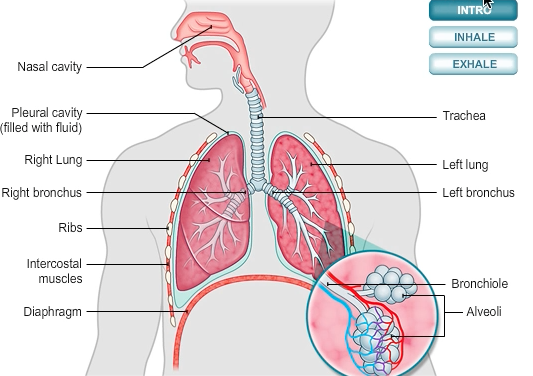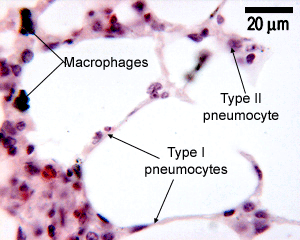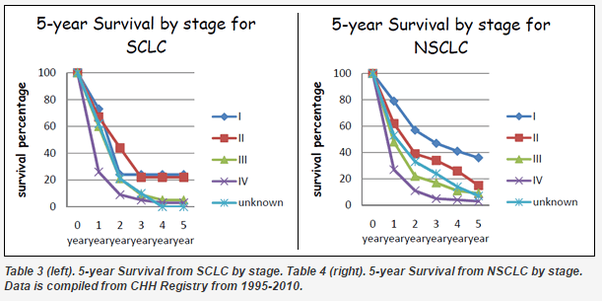topic 6.4: gas exchange
 image from Biology Questions
image from Biology Questions
In the Gas Exchange unit we will learn that the purpose of the respiratory system is to perform gas exchange. Pulmonary ventilation provides air to the alveoli for this gas exchange process. At the respiratory membrane, where the alveolar and capillary walls meet, gases move across the membranes, with oxygen entering the bloodstream and carbon dioxide exiting. It is through this mechanism that blood is oxygenated and carbon dioxide, the waste product of cellular respiration, is removed from the body.
This unit will last 3 school days
This unit will last 3 school days
Essential idea:
- The lungs are actively ventilated to ensure that gas exchange can occur passively.
Nature of science:
- Obtain evidence for theories—epidemiological studies have contributed to our understanding of the causes of lung cancer. (1.8)
- Define epidemiology.
- Outline how epidemiological studies contributed to understanding the association between smoking and lung cancer.
- Define epidemiology.
Applications
6.4.U1 Ventilation maintains concentration gradients of oxygen and carbon dioxide between air in alveoli and blood flowing in adjacent capillaries.
The processes involved in physiological respiration are:
Physiological respiration involves the transport of oxygen to cells within the tissues, where energy production occurs
- Ventilation: The exchange of air between the atmosphere and the lungs – achieved by the physical act of breathing
- Gas Exchange: The exchange of oxygen and carbon dioxide between the alveoli and bloodstream (via passive diffusion)
- Cell Respiration: The release of energy (ATP) from organic molecules – it is enhanced by the presence of oxygen (aerobic)
Physiological respiration involves the transport of oxygen to cells within the tissues, where energy production occurs
- Small single celled organisms can easily diffuse gas in and out of the cell as long as they are in an environment where concentration gradients exist for passive diffusion. For example, O2 in water can diffuse into a protist as long as the concentration of oxygen in the surrounding water is greater than the oxygen levels inside the protist cell.
- Human bodies are surrounded and protected by layers of skin. Thecells in the tissue that need oxygen for respiration are too far away, too protected, and too numerous to allow direct diffusion with their environment.
- Humans need a system to keep a fresh supply of O2 and to get rid of excess CO2.
- The ventilation system provides a fresh supply of O2 in the alveoli, allowing the oxygen to diffuse into the blood capillaries surrounding them
- The oxygen is then transported to all the tissues in the body.
- The CO2 in the tissues is transported by the blood to the lungs, where it diffuses into the alveoli and is exhaled into the surrounding atmosphere.
- Fresh supplies of O2 also makes sure that a steep concentration gradient exists where gas is exchanged to allow efficient exchange of O2
- The blood arriving at the alveoli via the pulmonary arteries, arterioles and then capillaries, is rich in CO2, thus creating a concentration gradient between the capillaries and the alveoli, allowing CO2 to rapidly diffuse out of the blood in the capillaries into the alveoli
6.4.U2 Type I pneumocytes are extremely thin alveolar cells that are adapted to carry out gas exchange.
Alveoli function as the site of gas exchange, and hence have specialised structural features to help fulfil this role.
Pneumocytes (or alveolar cells) are the cells that line the alveoli and comprise of the majority of the inner surface of the lungs
Pneumocytes (or alveolar cells) are the cells that line the alveoli and comprise of the majority of the inner surface of the lungs
- The walls of the alveoli are predominately made from a single layer of epithelial cells called Type I pneumocytes
- They are squamous (flattened) in shape and extremely thin (~ 0.15µm) – minimising diffusion distance for respiratory gases
- Since the alveoli are surrounded by capillaries that are also only one cell thick, oxygen and carbon dioxide have a very short distance to diffuse into the blood from the alveoli and out of the blood into the alveoli respectively
- This adaptation allows for a rapid rate of gas exchange
- Connected by occluding junctions, which prevents the leakage of tissue fluid into the alveolar air space
- Amitotic and unable to replicate, however type II cells can differentiate into type I cells if required.
6.4.U3 Type II pneumocytes secrete a solution containing surfactant that creates a moist surface inside the alveoli to prevent the sides of the alveolus adhering to each other by reducing surface tension.
Alveoli are lined by a layer of liquid in order to create a moist surface conducive to gas exchange with the capillaries
- It is easier for oxygen to diffuse across the alveolar and capillary membranes when dissolved in liquid
- About 5% of the inner surface of the alveoli consists of Type II pneumocytes
- These cells secrete a liquid made of proteins and lipids called surfactant
- This liquid allows oxygen to dissolve into the surfactant and then diffuse into the blood
- It also provides a medium for carbon dioxide to evaporate into the air inside the alveoli in order to be exhaled
6.4.U5 Air is carried to the lungs in the trachea and bronchi and then to the alveoli in bronchioles.
- Air enters the respiratory system through the nose or mouth and travels through the pharynx and then the trachea (made from rings of cartilage)
- The trachea divides into two bronchi (left and right)
- Inside each lung the bronchi divide into many smaller tubes called bronchioles
- These numerous bronchioles form a tree root-like structure that spreads throughout the lungs
- Each bronchiole ends in a cluster of air sacs called alveoli
6.4.U6 Muscle contractions cause the pressure changes inside the thorax that force air in and out of the lungs to ventilate them.
Breathing is the active movement of respiratory muscles that enables the passage of air into and out of the lungs. The contraction of respiratory muscles changes the volume of the thoracic cavity (i.e. the chest).
When the pressure in the chest is less than the atmospheric pressure, air will move into the lungs (inspiration)
When the pressure in the chest is greater than the atmospheric pressure, air will move out of the lungs (expiration
When the pressure in the chest is less than the atmospheric pressure, air will move into the lungs (inspiration)
When the pressure in the chest is greater than the atmospheric pressure, air will move out of the lungs (expiration
6.4.U7 Different muscles are required for inspiration and expiration because muscles only do work when they contract.
Inspiration (inhaling) and expiration (exhaling) are controlled by two sets of antagonistic muscle groups. When different muscles work together to perform opposite movements, they do so in an antagonistic fashion; when one muscle contracts the other will relax
- When muscles contract and shorten (do work), they exert a pulling force that causes movement
- The antagonistic muscle will relax and lengthen because of the pulling force of the other muscle; therefore no work is done
- For example, when one breaths in air, the external intercostal muscles contract, moving the ribcage up and out and the internal intercostal muscles relax (biceps and triceps work in similar fashion in our arms). The opposite occurs during expiration.
- Muscles therefore only cause movement in one direction while contracting (antagonistic pair relaxes). Movement in the other direction occurs when the other muscle of the pair contracts and the first muscle relaxes
Application
6.4.A1 Causes and consequences of lung cancer.
Lung cancer describes the uncontrolled proliferation of lung cells, leading to the abnormal growth of lung tissue (tumour). The abnormal growth can impact on normal tissue function, leading to a variety of symptoms according to size and location. The tumours can remain in place (benign) or spread to other regions of the body (malignant)
Smoking
Air Pollution
Radon Gas
Asbestos
Construction sites, factories and mines can have dust particles in the air. If steps aren’t taken to properly protect the worker's, lung cancers can develop.
Lung cancer is a very serious disease and the consequences can be severe, especially if the cancer is not recognized early on.
Smoking
- is the number one cause of lung cancer
- there is an extremely high correlation with the number of cigarettes an individual smokes in a day and the incidence of lung cancer
- Cigarettes contain a high number of carcinogens, such as polycyclic aromatic hydrocarbons and nitrosamines
- Second-hand smoke can also be considered a cause of cancer in non-smokers
Air Pollution
- Air pollution from exhaust fumes containing nitrogen oxides, fumes from diesel engines and smoke from burning carbon compounds such as coal are a minor cause of lung cancer. This depends on where in the world you live and the air quality.
Radon Gas
- In some parts of the world, this radioactive gas can leak out of certain rocks such as granite, accumulating in poorly ventilated buildings
Asbestos
Construction sites, factories and mines can have dust particles in the air. If steps aren’t taken to properly protect the worker's, lung cancers can develop.
Lung cancer is a very serious disease and the consequences can be severe, especially if the cancer is not recognized early on.
- If the tumour is large when it is discovered, metastasis might have occurred (cancer spreads to other parts of the body and forms secondary tumours). In these cases, mortality rates are very high. If the tumour is found early on, parts of the affected lung with the tumour can be removed and chemotherapy can be used to help kill the rest of the cancer cells. Re-occurrence of the disease is quite common.
6.4.A2 Causes and consequences of emphysema. (Oxford Biology Course Companion page 316).
- Outline the causes of lung cancer.
- List symptoms of lung cancer.
Emphysema is a lung condition whereby the walls of the alveoli lose their elasticity due to damage to the alveolar walls
- Emphysema is another respiratory disease that is often linked to smoking
- The loss of elasticity results in the abnormal enlargement of the alveoli, leading to a lower total surface area for gas exchange
- The degradation of the alveolar walls can cause holes to develop and alveoli to merge into huge air spaces (pulmona
- Phagocytes (white blood cells that engulf foreign bacteria) usually prevent lung infections and produce a hydrolytic enzyme called elastase
- An enzyme inhibitor usually prevents elastase from digesting lung tissue
- Smokers lungs generally contain a high number of these phagocytes/macrophages in their blood
- Since there is a higher level of phagocytes, more elastase is produced;however, not enough of the inhibitor that prevents elastase from digesting lung tissue
- This results in the destruction of elastic fibres of the alveolar walls by the enzyme elastase
- The alveoli can become over-inflated and fail to recoil properly
- Small holes can also develop in the walls of the alveoli
- The alveoli can merge forming huge air spaces and a lower surface area.
- This destruction cannot be reversed
6.4.A3 External and internal intercostal muscles, and diaphragm and abdominal muscles as examples of antagonistic muscle action.
Ventilation consists of inhalation (inspiration) and exhalation (expiration)
Inhalation
Inhalation
- External intercostal muscles contract pulling the ribs upwards and outwards.
- The diaphragm which is a flat sheet of muscle extending across the bottom of the rib cage contracts and flattens out.
- These two actions enlarge the thoracic cavity surrounded the lungs, thereby increasing the volume of the lungs.
- When the volume of the lungs increases, the pressure inside the lungs decreases and becomes lower than the pressure in the surrounding atmosphere.
- Since gas moves from higher pressure to lower pressure, air rushes into the lungs from the surrounding atmosphere to equalize the pressure.
- The external intercostal muscles relax and the diaphragm snaps back to its original shape (domed shape).
- This moves the ribs back down and inwards and decreases the volume of the thoracic cavity and the lungs.
- This decrease in volume increases the pressure inside the lungs.
- Since the pressure inside the lungs is now greater than the atmospheric pressure, and gas moves from high pressure to low pressure, air rushes out of the lungs into the surrounding environment.
- NOTE: If there is a forced exhalation (push and squeeze the air out of the lungs) the internal intercostal muscles will also contract along with the abdominal muscles to pull the rib cage down and squeeze the organs in the abdomen
Skills
6.4.S1 Monitoring of ventilation in humans at rest and after mild and vigorous exercise. (Practical 6)
Ventilation in humans changes in response to levels of physical activity, as the body’s energy demands are increased
- ATP production (via cellular respiration) produces carbon dioxide as a waste product (and may consume oxygen aerobically)
- Changes in blood CO2 levels are detected by chemosensors in the walls of the arteries which send signals to the brainstem
- As exercise intensity increases, so does the demand for gas exchange, leading to an increase in levels of ventilation
- Increase ventilation rate (a greater frequency of breaths allows for a more continuous exchange of gases)
- Increase tidal volume (increasing the volume of air taken in and out per breath allows for more air in the lungs to be exchanged)
Key Terms:
|
respiratory
respiration diaphragm pharynx alveoli inhalation gas volume antagonistic muscle |
carbon dioxide
diffusion intercostal muscles larynx lung capacity type I pneumocytes gas pressure lung cancer |
oxygen
ATP abdominal muscles trachea air inhaled type II pneumocytes inspiration abdominal muscles |
gas exchange
energy concentration bronchi thoracic cavity surfactant emphysema lung tidal volume |
ventilation
aerobic capillary bed bronchioles expiration bronchi ventilation rate epidemiology |
REMEMBER...RESPIRATION IS NOT BREATHING
Class Materials:
Gas Exchange Webquest
Gas Exchange worksheet
Surface to Volume Area tutorial
Sheep Lung dissection
Topic 6.4 Review
Class Materials:
Gas Exchange Webquest
Gas Exchange worksheet
Surface to Volume Area tutorial
Sheep Lung dissection
Topic 6.4 Review
PowerPoint and Notes on Topic 6.4 by Chris Paine
Your browser does not support viewing this document. Click here to download the document.
Your browser does not support viewing this document. Click here to download the document.
Correct use of terminology is a key skill in Biology. It is essential to use key terms correctly when communicating your understanding, particularly in assessments. Use the quizlet flashcards or other tools such as learn, scatter, space race, speller and test to help you master the vocabulary.
External Links:
Stress-busting breathing exercises from Health and Yoga
In the Gas Exchange animation from McGraw Hill
Breathing mechanism animation from Footprints Science
Alveoli animation from Footprints Science
Get Body Smart – Respiratory System tutorials
KFU Respiratory system animation
Respiratory system animation from http://teachhealthk-12.uthscsa.edu/
NHS UK: Asthma animation
In The News:
from InScience Organisation New Inhaler System Could Be Breakthrough for Disease Treatment
World First: Lungs Awaiting Transplant Preserved 11 Hours Outside Body from Science Daily
Exhaled Breath Biomarker May Detect Lung Cancer from Science Daily
Video Clips:
When you breathe, you transport oxygen to the body’s cells to keep them working, while also clearing your system of the carbon dioxide that this work generates. How do we accomplish this crucial and complex task without even thinking about it? Emma Bryce takes us into the lungs to investigate how they help keep us alive.
How to draw an IB ventilation system
In which Hank does some push ups for science and describes the "economy" of cellular respiration and the various processes whereby our bodies create energy in the form of ATP.
So we all know that breathing is pretty important, right? Today we're going to talk about how it works, starting with the nameless evolutionary ancestor that we inherited this from, and continuing to the mechanics of both simple diffusion and bulk flow, as well as the physiology of breathing, and finishing with the anatomy of both the conducting zone and the respiratory zone of your respiratory system.
Can a paper bag really help you when you are hyperventilating? It turns out that it can. In part 2 of our look at your respiratory system Hank explains how your blood cells exchange oxygen and CO2 to maintain homeostasis. We'll dive into partial pressure gradients, and how they, along with changes in blood temperature, acidity, and CO2 concentrations, change how hemoglobin binds to gases in your blood. (And yes, we'll explain the paper bag thing too!)
Paul Andersen starts this video with a description of the respiratory surface. He explains how worms, insects, fish and mammals take in oxygen and release carbon dioxide. He then tours the major organs of the respiratory system; from the pharynx to the trachea, bronchus, bronchiole and alveoli. He also explains how oxygen is carried on the hemoglobin and how carbon dioxide is carried as bicarbonate.
Great animation on gas exchange
Dr. Keshavjee unveils a mechanical lung on stage and describes how this transplant technology is saving lives
Paul Andersen starts this video with a description of the respiratory surface. He explains how worms, insects, fish and mammals take in oxygen and release carbon dioxide. He then tours the major organs of the respiratory system; from the pharynx to the trachea, bronchus, bronchiole and alveoli. He also explains how oxygen is carried on the hemoglobin and how carbon dioxide is carried as bicarbonate.














